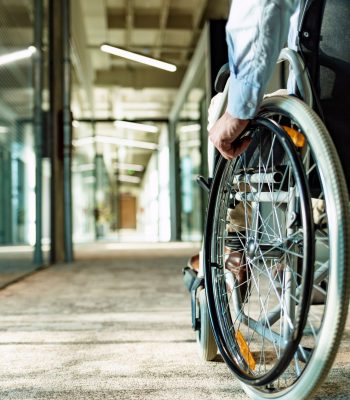Description
Universal design (UD) means designing services, facilities, products and environments to be used by all people, regardless of physical ability, age and other factors. Evidence shows that lack of or limited access to urban services such as resilient housing, transport and information technology exacerbates the exclusion of underserved groups from economic and social opportunities, leading to high opportunity costs for society as a whole.[1]
Ongoing urbanisation and extended life expectancy in many countries have also raised awareness of the need for more accessible cities. Recognising the importance of promoting accessible cities, many international policies and initiatives have incorporated the concept of UD, including the United Nations Sustainable Development Goals, the New Urban Agenda and the Convention on the Rights of Persons with Disabilities.
In 1997, a group of US architects and engineers proposed seven UD principles to guide the design of accessible product and environment. These now widely acknowledged principles include: (i) equitable use, (ii) flexibility in use, (iii) simple and intuitive use, (iv) perceptible information, (v) tolerance for error, (vi) low physical effort, and (vii) size and space for approach and use.[2]
UD principles can be applied across services and infrastructures in the city. For instance, features like a step-free entrance, accessible lifts and larger toilet compartments in residential and public built environments allow people with limited physical abilities to use buildings, parks and other public spaces safely and comfortably.
The Queen Elizabeth Olympic Park in London provides a good example of accessible public space design. With the aim of building a “park for all”, it includes UD features such as step-free access, coordinated crossings, hard-standing surfaces, assistance-dog facilities, regular seating and all-gender toilets. These facilities have enabled a wide range of visitors to access green space, sports and cultural activities.
Another crucial area for promoting UD is transport. UD principles can be integrated throughout the travel chain. The starting points are sidewalks and streets – pedestrian ramps, tactile paving surfaces and safe rest points on busy roads will significantly improve the mobility of wheelchair users or people with impaired vision. Meanwhile, all modes of public transport can also use a wide range of low-cost UD measures, such as priority seating, lift equipment and audio announcement systems.
In cities that have relatively poor street infrastructure and public transport services, demand-responsive transport (DRT) might be a more viable option. Ljubljana, Slovenia, has provided DRT services since 2008 – by simply booking via phone, passengers with limited physical abilities can travel independently and safely on vehicles with a ramp or a low floor.[3]
Moreover, as information and communication technologies (ICTs) and digital solutions are increasingly integrated into urban lives, it is vital to ensure that ICT products and services are also accessible. This has great potential to enable people with limited physical abilities to participate in economic, cultural and social activities.[4]
UD can be considered in the development of government websites, public kiosks, digital signage, mobile devices and applications, and so on. Cities can encourage private sector actors to engage in the research and development of accessible ICT through public procurement or legislation.

Resource implications and key requirements
A typical first step is using access audits to understand a city’s current accessibility conditions. For instance, Shanghai, China, conducts a transport accessibility audit every year, engaging older people and people with disabilities to prioritise problems and improve city planning. Some of the identified issues include damaged sidewalks and dropped kerbs.[5]
Then, city governments could determine the UD solutions that can improve accessibility based on national standards and public consultation. Depending on the solutions, different levels of capital investments might be needed for asset design, construction and maintenance.
Note that retrofitting existing facilities is as important as building new ones, and thus a holistic plan is needed to ensure that all facilities created in the past, present and future are universally accessible.
Cities could consider providing financial incentives for private asset owners or service providers to mainstream the adoption of UD. Singapore’s Accessibility Fund, for instance, provides grants up to around US$ 227,000 per development for upgrading private buildings with UD features. The Fund co-pays up to 80 per cent of the expense for basic features such as signage, passenger lifts and accessible toilets, as well as up to 60 per cent for additional facilities like diaper changing stations and braille and tactile features. , the Fund has supported more than 130 private developments across the city.[6]
Promoting UD also needs policy reforms and regulatory measures. Cities need to allow for better integrated and coordinated planning across different sectors and agencies, particularly between transport and land use. Also, local governments can develop bylaws and regulations to enforce accessibility standards – including active use of building permits – as well as establish regular monitoring and enforcement mechanisms.
As an example, in Kuala Lumpur, Malaysia, a building permit for any new construction or retrofitting work can only be issued if it complies with national accessibility standards. Every submitting person must sign a certification indicating that they will assume full responsibility in the case of non-compliance. During and after the construction, access statements, inspections and audits are used for monitoring and enforcement.
Another impactful reform is to make UD adoption an integral part of public procurement and funding systems. Cities could require relevant public service projects to incorporate UD concepts during planning, feasibility studies and operation. In fact, the European Accessibility Act became law in 2019, which mandates that public procurement of goods and services specified in the Act must comply with specified “design for all” requirements – equivalent to the UD approach.[7]

Implementation obstacles and solutions
Lack of awareness and commitment among policymakers, investors and service providers remains a major barrier. This can be observed from the rapid urban sprawl that gives less attention to cycling and walking than to motorised transport, and limited accessibility of services and products in cities across EBRD regions.
There is also a temptation to prioritise speed and to minimise development costs in rapidly growing cities. Therefore, it is crucial that everyone involved in the design, development and implementation of urban services realises the significance of improving accessibility and applies the UD approach in practice – both from a social and an economic perspective.
One solution is to provide formal training and guidance to those working on urban planning and procurement, from senior managers to transport employees, helping them build a comprehensive perspective of different citizens’ needs, equip them with the necessary UD toolkits and fully incorporate UD into their work. City governments can establish a knowledge transfer framework to share design standards, legal requirements and best practices to relevant agencies and businesses. Adequate modelling of economic costs of ignoring or delaying UD requirements can also help. Such modelling may include forecasting the age composition for the relevant cities.
In addition, urban planning often faces an inadequate level of public consultation and engagement. Stakeholder participation is an effective way to raise awareness and understand people’s needs. A well-represented group of stakeholders should be involved in the processes as active co-owners who can bring their own voice and experience.
Given that people with disabilities will benefit the most from UD solutions, any form of public consultation should take their conditions into account and remove logistics barriers that may hamper their involvement (see policy option Effective Stakeholder Participation).

References
[1] United Nations (2016), “Good practices of accessible urban development”.
[2] Centre for Excellence in Universal Design (n.d.), “The 7 Principles”.
[3] Interreg Europe (n.d.), “Demand-Responsive Transport Service for Persons with Disabilities in Ljubljana Urban Region”.
[4] ITU (2013), “The ICT opportunity for a disability-inclusive development framework”.
[5] Transformative Urban Mobility Initiative (TUMI) (2019), “Disability Inclusive Public Transport”.
[6] Building and Construction Authority (n.d.), “Accessibility Fund”.
[7] United Nations Economic and Social Commission for Asia and the Pacific (ESCAP) (2019), “Disability-inclusive public procurement: Promoting universal design and accessibility”.








